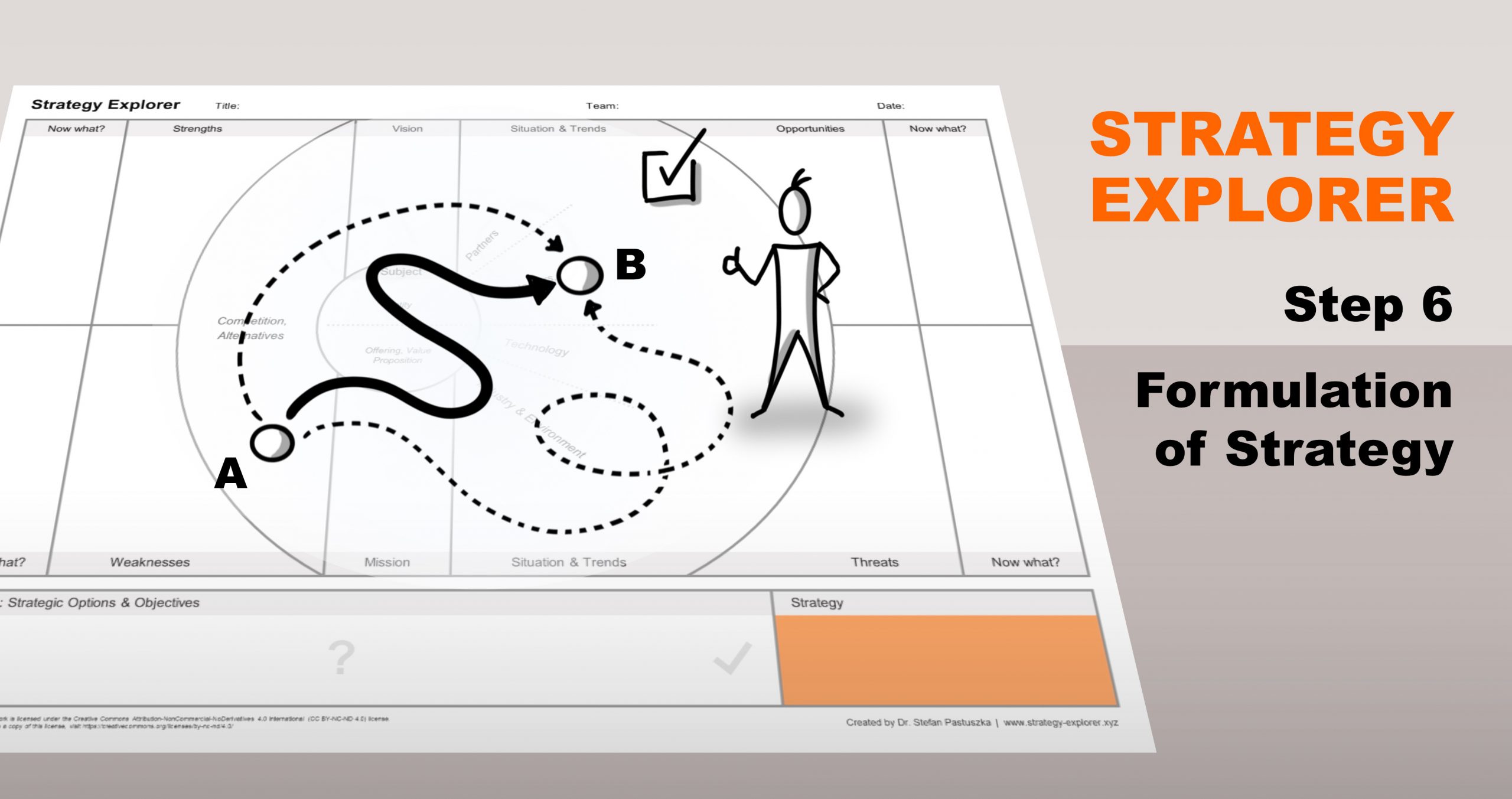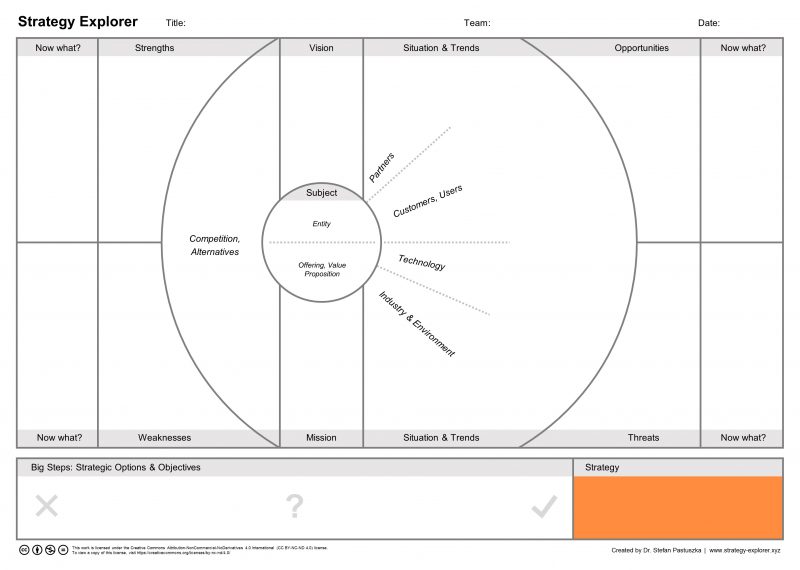Did you ever ask employees of an organization about its strategy? You might be surprised by the variety of answers – although all work for the same employer. Ideally, everyone working in an organization should have a common understanding of the overarching goals and how to generally accomplish them – only then, everybody can contribute in the best possible way. Of course, not everybody needs to know all details, but it helps when the essence is understood. For that, you need a clear story. And to create that story, you first need clarity about the way forward and to formulate it crisply and to the point. This is the sixth and final step of the Strategy Explorer process and its outcome will be an excellent basis for implementation and communication.
Decide on the Way Forward
The formulation of the strategy as the most promising way forward requires some entrepreneurial spirit, creativity and abstraction. It consists of one or more of the preferred options identified in the previous working phase (“Big Steps”) where you prioritized the available alternatives. Now, an entrepreneurial decision is required to create and pursue the route you really wish to take.
- If you have a choice of suitable options which are mutually exclusive, you will need to decide about which alternative to take. Possibly, the final decision will involve further analysis and discussions outside the group you have assembled in your strategy workshop. However, in most cases you will be able to recognize the best alternative based on the accumulated knowledge and experience in the room.
- In case the preferred options and big steps are not exclusive, your way forward can be based on a sound selection of steps which harmonize well and help you achieve your vision.
Collect the essential steps for your strategy in the field named “Strategy” in the Strategy Explorer (see image). Do not move your notes from the “Big Steps” field, but write them anew – in a reformulated or more aggregated way, if required.
Formulate a Strategy Sentence
Now you need to climb to the next level of flight altitude to put everything into perspective. When asked about your strategy, people are typically not interested in a 15 minute speech. Instead, you need to communicate briefly and to the point – like in an elevator pitch. Ideally, a strategy can be formulated in one or two sentences, as shown in the following template:
“We achieve our vision (=?) by doing X, Y, and Z (short list).”
Here, “short list” names the major measures or objectives that describe the chosen strategic path. The list might contain a few items, like about three, or even consist of just one very central and crucial point. You can see this step as a further filtering stage after the “Big Steps” phase that leaves you with the essence of your strategy. In order to produce a concise formulation, some creativity and abstraction is required: identify the essential steps and combine them to a comprehensible logic. It might be necessary to cluster individual aspects that contribute to the same objective or action field: Let’s assume you have realized that your company needs an influx of new talent to stay competitive and several of your identified Big Steps contribute to this objective, like “launch employer branding campaign”, “intensify social media recruiting”, and “more resources for HR”. Then, the essential ingredient for your story would be “active recruiting of new talents” rather than a list of the individual measures.
After you have distilled the essential steps, you need to bring them into a comprehensible order. The following strategy sentence is an example that is formulated according to the template:
“We will be the leading provider of low-cost XY in the market by massively expanding our production facilities in Indonesia, qualifying alternative suppliers and consistently switching to digital sales channels.”
In a very concise but comprehensible way, this lines out the overarching goal and the crucial steps to achieve it.
Quick-test the Strategy Sentence
Formulating the strategy sentence is not that easy and it will certainly take a few attempts to nail it down. However, a simple and effective test for the strategy sentence is to simply vocalize in the workshop: just say it out loud! This way, you will quickly see whether it sounds comprehensible and you feel good with the result:
- Is the sentence comprehensible, consistent and credible?
- Does it sound authentic?
- Does it make clear what needs to be achieved and done?
- Does the described way feel right and feasible?
- Does it have the right flight altitude, i.e., is it really strategic?
- Can the statement be easily memorized?
If you are convinced that your selected way forward will be successful and you can recite the strategy sentence convincingly to yourself and the team, you have already accomplished a lot. Of course, in many cases, you will need further research, analyses and discussions to ascertain the viability, but the general direction and the potential alternatives are clear now.
Go Ahead
With the concise strategy sentence, you have formulated the strategy at a high level. For implementation, strategic objectives need to be laid out in more detail, typically as the basis for action plans or in the form of OKR to get things done. In this phase, you might still discover that the overall strategy is not viable without adjustments because of deeper insights or unexpected obstacles. In this case, you need to take a step back and check or develop other promising options.
The elaboration of the details and the implementation of the strategy are not part of the work with the Strategy Explorer – this is done subsequently using standard methods. The purpose of the Strategy Explorer is to help you recognize the most promising way to achieve your vision and to have it clearly formulated on a high level. This is the basis for a successful implementation and communication of your strategy.
Therefore, if you ask the employees of your organization about its strategy and the answer is unambiguous and correct, you did it right. I hope that your work with the Strategy Explorer will (or already did) help you to achieve this result. I wish you a lot of inspiration, fruitful discussions, and finally great success in developing the right strategies using the Strategy Explorer. Please let me know about your experiences – and feel free to contact me if you need advice or support!


